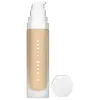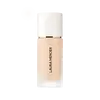Fenty Beauty Soft’Lit Naturally Luminous Longwear Foundation Versus Laura Mercier Real Flawless Weightless Perfecting Waterproof Foundation
What's inside
What's inside
 Key Ingredients
Key Ingredients

 Benefits
Benefits

 Concerns
Concerns

 Ingredients Side-by-side
Ingredients Side-by-side

Water
Skin ConditioningDimethicone
EmollientButylene Glycol Dicaprylate/Dicaprate
EmollientDiphenylsiloxy Phenyl Trimethicone
Skin ConditioningGlycerin
HumectantSynthetic Fluorphlogopite
Cetyl PEG/PPG-10/1 Dimethicone
EmulsifyingTrisiloxane
Skin ConditioningButylene Glycol
Humectant1,2-Hexanediol
Skin ConditioningTrimethylsiloxysilicate
EmollientDisteardimonium Hectorite
StabilisingPEG-10 Dimethicone
Skin ConditioningPolyphenylsilsesquioxane
Magnesium Sulfate
Dimethicone Crosspolymer
Emulsion StabilisingLauroyl Lysine
Skin ConditioningTriethoxycaprylylsilane
Aluminum Hydroxide
EmollientPolyhydroxystearic Acid
EmulsifyingEthylhexyl Palmitate
EmollientIsopropyl Myristate
EmollientIsostearic Acid
CleansingLecithin
EmollientTerminalia Ferdinandiana Fruit Extract
AntioxidantTrisodium Ethylenediamine Disuccinate
Polyglyceryl-3 Polyricinoleate
EmulsifyingCyperus Rotundus Root Extract
Skin ConditioningCI 77891
Cosmetic ColorantIron Oxides
Water, Dimethicone, Butylene Glycol Dicaprylate/Dicaprate, Diphenylsiloxy Phenyl Trimethicone, Glycerin, Synthetic Fluorphlogopite, Cetyl PEG/PPG-10/1 Dimethicone, Trisiloxane, Butylene Glycol, 1,2-Hexanediol, Trimethylsiloxysilicate, Disteardimonium Hectorite, PEG-10 Dimethicone, Polyphenylsilsesquioxane, Magnesium Sulfate, Dimethicone Crosspolymer, Lauroyl Lysine, Triethoxycaprylylsilane, Aluminum Hydroxide, Polyhydroxystearic Acid, Ethylhexyl Palmitate, Isopropyl Myristate, Isostearic Acid, Lecithin, Terminalia Ferdinandiana Fruit Extract, Trisodium Ethylenediamine Disuccinate, Polyglyceryl-3 Polyricinoleate, Cyperus Rotundus Root Extract, CI 77891, Iron Oxides
Isododecane
EmollientIsodecyl Neopentanoate
EmollientHydrogenated Polyisobutene
EmollientHydrogenated Polycyclopentadiene
Hydrogenated Didecene
Skin ConditioningSilica
AbrasivePolyglyceryl-3 Diisostearate
EmulsifyingHydrogenated Styrene/Isoprene Copolymer
Dicalcium Phosphate
AbrasiveDisteardimonium Hectorite
StabilisingCellulose
AbsorbentLauryl PCA
HumectantTheobroma Cacao Seed Extract
AntioxidantHydrogenated Lecithin
EmulsifyingCamellia Oleifera Seed Oil
Skin ConditioningWater
Skin ConditioningPentaerythrityl Tetra-Di-T-Butyl Hydroxyhydrocinnamate
AntioxidantTocopheryl Acetate
AntioxidantButylene Glycol
HumectantIron Oxides
CI 77891
Cosmetic ColorantIsododecane, Isodecyl Neopentanoate, Hydrogenated Polyisobutene, Hydrogenated Polycyclopentadiene, Hydrogenated Didecene, Silica, Polyglyceryl-3 Diisostearate, Hydrogenated Styrene/Isoprene Copolymer, Dicalcium Phosphate, Disteardimonium Hectorite, Cellulose, Lauryl PCA, Theobroma Cacao Seed Extract, Hydrogenated Lecithin, Camellia Oleifera Seed Oil, Water, Pentaerythrityl Tetra-Di-T-Butyl Hydroxyhydrocinnamate, Tocopheryl Acetate, Butylene Glycol, Iron Oxides, CI 77891
 Reviews
Reviews

Ingredients Explained
These ingredients are found in both products.
Ingredients higher up in an ingredient list are typically present in a larger amount.
Butylene Glycol (or BG) is used within cosmetic products for a few different reasons:
Overall, Butylene Glycol is a safe and well-rounded ingredient that works well with other ingredients.
Though this ingredient works well with most skin types, some people with sensitive skin may experience a reaction such as allergic rashes, closed comedones, or itchiness.
Learn more about Butylene GlycolCi 77891 is a white pigment from Titanium dioxide. It is naturally found in minerals such as rutile and ilmenite.
It's main function is to add a white color to cosmetics. It can also be mixed with other colors to create different shades.
Ci 77891 is commonly found in sunscreens due to its ability to block UV rays.
Learn more about CI 77891Disteardimonium Hectorite comes from the clay mineral named hectorite. It is used to add thickness to a product.
It can also help stabilize a product by helping to disperse other ingredients.
Hectorite is a rare, white clay mineral.
Learn more about Disteardimonium HectoriteWater. It's the most common cosmetic ingredient of all. You'll usually see it at the top of ingredient lists, meaning that it makes up the largest part of the product.
So why is it so popular? Water most often acts as a solvent - this means that it helps dissolve other ingredients into the formulation.
You'll also recognize water as that liquid we all need to stay alive. If you see this, drink a glass of water. Stay hydrated!
Learn more about WaterThis ingredient is a combination of red, black, and yellow iron oxide pigments. This combination of colors is usually found in foundation, because it results in a "skin" color.